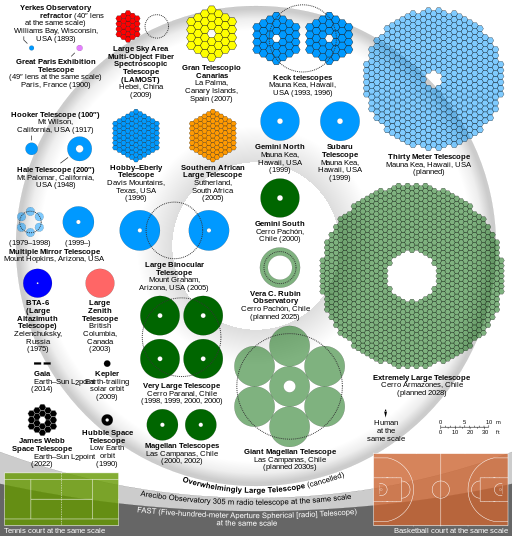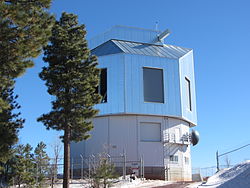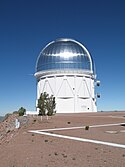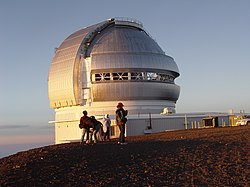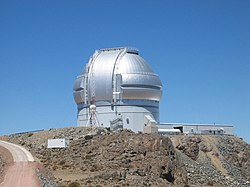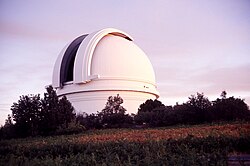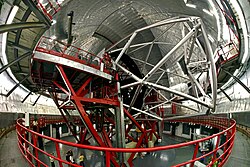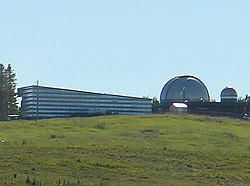Comparison optical telescope primary mirrors
The telescopes shown on this comparison chart are listed below, ordered in each sub-section by (effective) mirror/lens area, low to high, and then by actual/planned first light date, old to new. The "present-day" status is given as of the beginning of 2024. See also List of largest optical reflecting telescopes.
Largest refractors (for comparison):
- 1) Yerkes Observatory's 40-inch (1.02 m) refractor, 1893 (largest refractor consistently used for scientific observations)
- 2) Great Paris Exhibition Telescope, 49 inches (1.24 m), 1900 (largest refractor ever built; had practically no scientific usage)
Ground-based reflectors:
- 3) Hooker Telescope, 100 inches (2.54 m), 1917; world's largest telescope from 1917 to 1949
- 4) Multiple Mirror Telescope, 186 inches (4.72 m) effective, 1979–1998; 6.5 m, from 1998
- 5) LAMOST (Large Sky Area Multi-Object Fiber Spectroscopic Telescope), 4.9 m effective at best, 2009
- 6) Hale Telescope, 200 inches (5.1 m), 1949; world's largest telescope from 1949 to 1975
- 7) BTA-6, 6 m, 1975; world's largest telescope from 1975 to 1990 (when it was surpassed by the partially-completed Keck I telescope)
- 8) Large Zenith Telescope, 6 m, 2003; largest liquid-mirror telescope ever built; decommissioned in 2019
- 9) Magellan Telescopes, two 6.5‑m individual telescopes, 2000 and 2002;
- 10) Vera C. Rubin Observatory (formerly Large Synoptic Survey Telescope), 6.68 m effective (8.4‑m mirror, but with a big hole in the middle), planned 2025
- 11) Gemini Observatory, 8.1 m, 1999 and 2001
- 12) Subaru Telescope, 8.2 m, 1999; largest monolithic (i.e. non-segmented) mirror in an optical telescope from 1999 to 2005
- 13) Southern African Large Telescope, 9.2 m effective, 2005 (largest optical telescope in the southern hemisphere)
- 14) Hobby–Eberly Telescope, 10 m effective, 1996
- 15) Gran Telescopio Canarias, 10.4 m, 2007 (world's largest single-aperture optical telescope)
- 16) Large Binocular Telescope, 11.8 m effective (two 8.4‑m telescopes on a common mount), 2005 and 2006; each individual telescope has the largest monolithic (i.e. non-segmented) mirror in an optical telescope, while the combined effective light collecting area is the largest for any optical telescope in non-interferometric mode
- 17) Keck Telescopes, 14 m effective (two 10‑m individual telescopes), 1993 and 1996; similarly to VLT, the two telescopes were combined only for interferometric observations rather than to simply achieve larger light collecting area; furthermore, this mode has been discontinued
- 18) Very Large Telescope, 16.4 m effective (four 8.2 m individual telescopes), 1998, 1999, 2000, and 2000; total effective light collecting area would have been world's largest for any present-day optical telescope, but the instrumentation required to obtain a combined incoherent focus was not built
- 19) Giant Magellan Telescope, 22.0 m effective, planned for early 2030s
- 20) Thirty Meter Telescope, 30 m effective, planned (no specific dates yet)
- 21) Extremely Large Telescope, 39.3 m effective, planned 2028
- 22) Overwhelmingly Large Telescope, 100 m, cancelled
Space telescopes:
- 23) Gaia, 1.45 m × 0.5 m (area equivalent to a 0.96‑m round mirror), 2013
- 24) Kepler, 1.4 m, 2009
- 25) Hubble Space Telescope, 2.4 m, 1990
- 26) James Webb Space Telescope, 6.5 m effective, 2022 (largest space optical telescope to date)
Radio telescopes for comparison:
- 27) Arecibo Observatory's 305‑m dish; largest fully-filled single-aperture telescope from 1963 to 2016 (the largest-aperture telescope of any kind is the very-sparsely-filled RATAN-600 radio telescope)
- 28) Five-hundred-meter Aperture Spherical [radio] Telescope (FAST), 500‑m dish (effective aperture of ≈300 m), 2016; world's largest fully-filled single-aperture telescope (since 2016)
Other objects for comparison:
- 29) Human height, 1.77 m on average
- 30) Tennis court, 78 × 36 ft (23.77 × 10.97 m)
- 31) Basketball court, 94 × 50 ft (28.7 × 15.2 m)
Relevante Bilder
Relevante Artikel
Liste der größten optischen TeleskopeDie Liste der größten optischen Teleskope enthält Teleskope für Strahlung mit einer Wellenlänge kleiner 100 µm, die beugungs- bzw. Seeing-begrenzte Abbildung haben:Rang Durchmesser: Maß der optischen Hauptkomponente / des flächenmäßig entsprechenden Kreises ; die Angaben können wegen der auch üblichen Zoll-Maße leicht differieren (Rundungen) Höhe: Lage über dem Meeresspiegel Jahr der Inbetriebnahme: Zum Teil können die in verschiedenen Quellen angegebenen Daten für die Fertigstellung um ein Jahr oder mehr differieren. Dies liegt meistens daran, dass „Inbetriebnahme“ unterschiedlich definiert ist. .. weiterlesen
Extremely Large TelescopeDas Extremely Large Telescope (ELT), zuvor European Extremely Large Telescope (E-ELT), ist ein im Bau befindliches optisches Teleskop der nächsten Generation für die Europäische Südsternwarte (ESO). Es erhält einen Hauptspiegel mit 39 Metern Durchmesser, der aus 798 sechseckigen Spiegelelementen zusammengesetzt sein wird. Damit soll es das weltweit größte optische Teleskop werden. .. weiterlesen
Gran Telescopio CanariasDas Gran Telescopio Canarias (GTC) ist ein astronomisches Großteleskop mit 10,4 m Spiegeldurchmesser auf dem Roque de los Muchachos auf der Kanareninsel La Palma. Gebräuchlich ist auch die Bezeichnung GRANTECAN. .. weiterlesen
